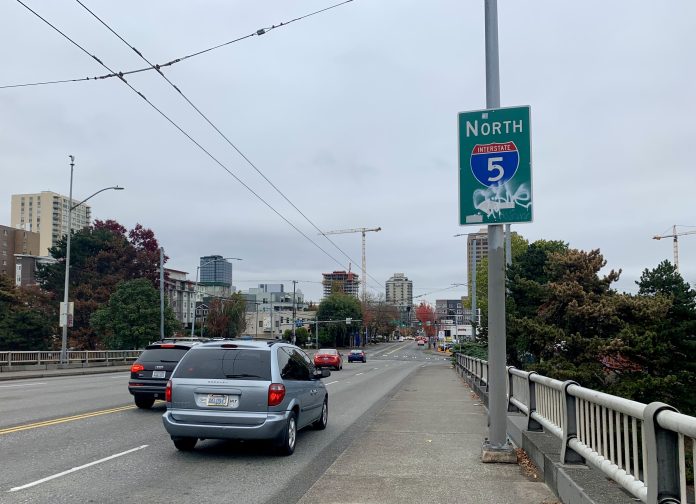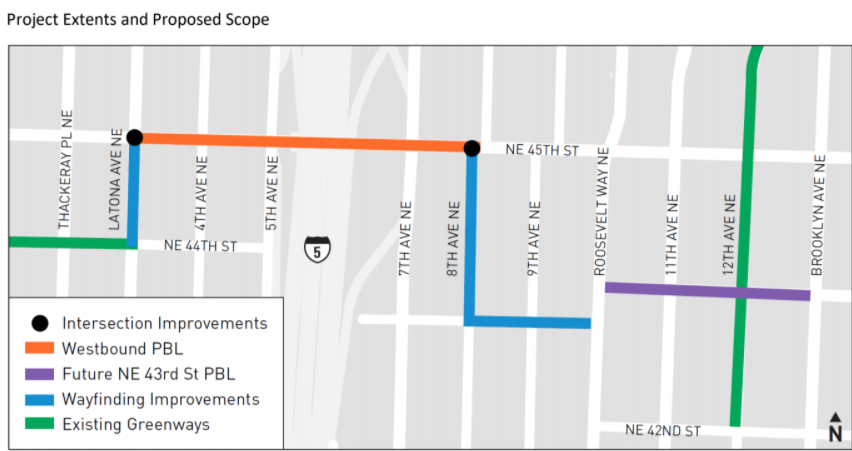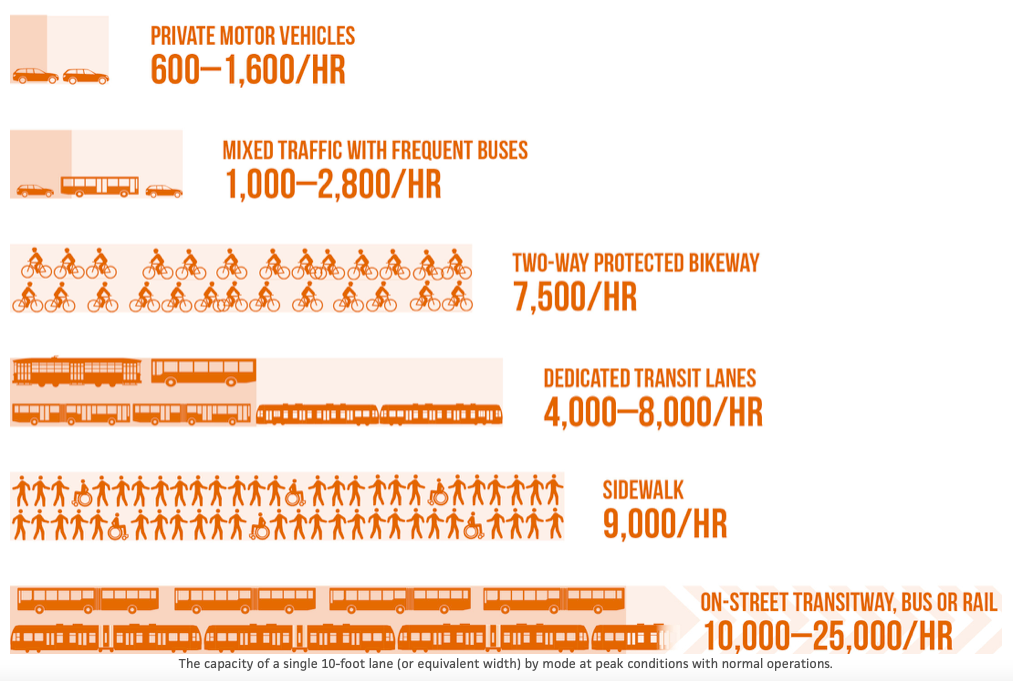This article was updated on 10/26/2021 to reflect that it was the U District Community Council, not the U District Partnership, that submitted a letter to the City of Seattle.
The segment of NE 45th Street near Interstate 5 in Seattle does not provide a safe or comfortable connection for pedestrians and cyclists accessing the new U District light rail station from Wallingford and other neighborhoods to the west. Providing a safe connection has been a priority for years. However, a protected bike lane (PBL) being studied on NE 45th Street bridge over I-5 has been dropped by the Seattle Department of Transportation (SDOT) from plans for its Route 44 Transit-Plus Multimodal Corridor project. The agency points to concerns about impacts to vehicle and transit traffic, as well as cost.
Safe street advocates, including The Urbanist and a coalition of partner organizations, aren’t giving up yet, and are calling on SDOT to make good on promises to improve the corridor for pedestrians and cyclists, a priority laid out in the 2015 Move Seattle levy. Last fall, the Seattle City Council added $400,000 in funding, as requested by the Move All Seattle Sustainably (MASS) Coalition, in hopes of adding the protected bike lane and a jersey barrier for people walking and rolling on the bridge.
The Route 44 Multimodal Corridor project is anticipated to go out to bid sometime in October. As it stands, planned safety improvements near the I-5 crossing are limited to pedestrian improvements at the intersection of NE 45th Street and 8th Avenue NE, located one block east of the I-5 overpass. These planned changes fall short of safety improvements that had been under consideration for the corridor, including a westbound PBL over the I-5 bridge, which the agency declared feasible in 2020 report, although the question of funding for the PBL remained up in the air.
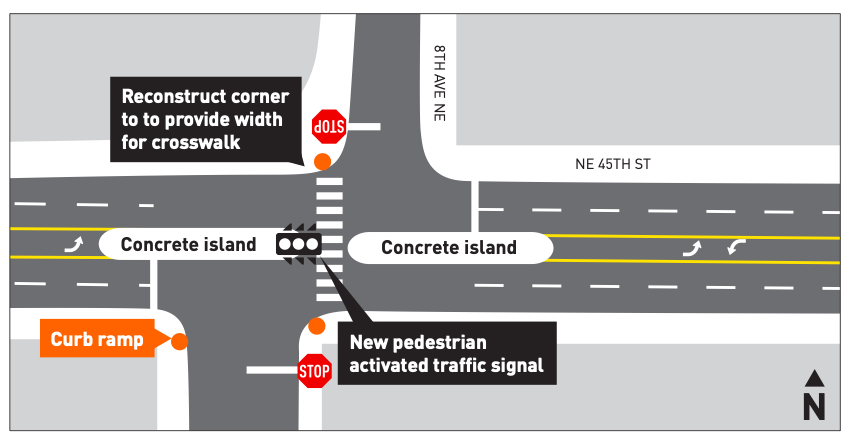
In a letter submitted to the Seattle City Council, The Urbanist, Transit Riders Union, Cascade Bicycle Club, and Seattle Neighborhood Greenways have put forth three primary demands: a PBL connecting over the I-5 bridge, an interchange and wayfinding for cyclists at NE 8th Avenue, and added protection for pedestrians on the I-5 bridge.
SDOT – Bike Lane on 45th Street Bridge Over I-5 by Natalie Bicknell on Scribd
However, in an official statement shared with The Urbanist, SDOT defended its decision to drop plans for a NE 45th Street bridge PBL, stating that the agency “ultimately determined that the bike lane concept was infeasible for a variety of reasons” after consulting with the Washington State Department of Transportation (WSDOT) on the corridor study.
A part of this study included creating traffic models, which made it clear that a bike lane would raise a number of operational concerns for the local transportation network in all directions. In addition to concerns about backups onto I-5, we were also concerned about east-west travel conflicts on the overpass, and far-reaching delays for transit along the Route 44 corridor.
SDOT, 10/12/2021
SDOT also reiterated that the PBL on NE 45th Street was not included in the Bicycle Master Plan and that it had only been added to the the Route 44 Multimodal Corridor project after it was “already part-way through the design phase.” This conveniently sidesteps the commitment in the Move Seattle Levy and the U District Station Area Mobility Plan.
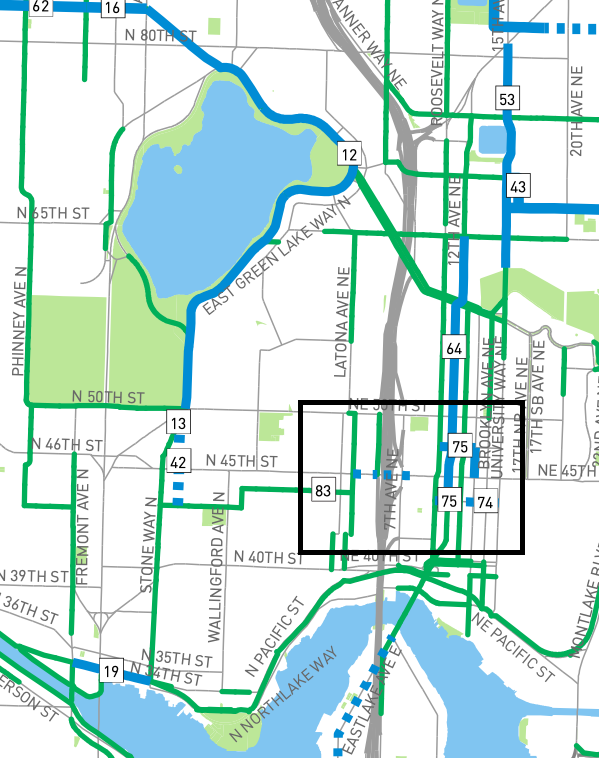
In a separate communication shared with Seattle Neighborhood Greenways (SNG), SDOT cited specific concerns over the removal of westbound through lane on NE 45th Street to create the PBL, which the agency said would result in “major backups on the [northbound] off ramp which has been modeled to extend onto I-5,” causing a “significant safety concern” as well as significant impacts to east and westbound traffic flow.
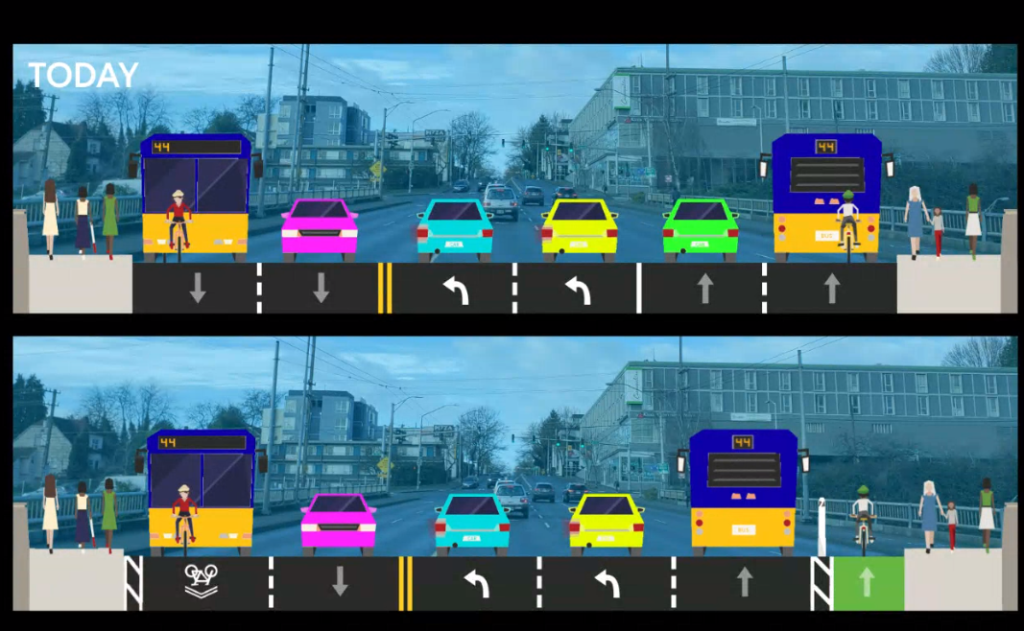
According to SDOT, to resolve the issue, WSDOT called for the creation of “complete redesign (reconstruction) of the [northbound] off ramp to accommodate the modeled backups.” However, SDOT described this solution as financially out of reach, stating, “This is clearly something we definitely don’t have budget for.”
WSDOT initially stated they would provide comment for The Urbanist, but then did not give a statement separate from the one provided by SDOT.
The issue of congestion on I-5 through the U District hardly seems to hinge on an extra left turn lane on the NE 45th Street bridge that can only store a few cars anyway. I-5 is already frequently congested here, and it’s hard to imagine the impact of second left turn lane would be that substantial.
U District Community Council calls for stop to Route 44 plans
Disappointed that years of community engagement and planning will not result in desired safety improvements for pedestrians and cyclists on the NE 45th Street bridge over I-5, the U District Community Council has demanded that SDOT put a halt to its Route 44 Multi-Modal Corridor plans.
“The [U District] station opening is imminent, but we are ill-prepared for the anticipated influx of pedestrians and bicyclists and we must do better to avoid further collisions,” the letter addressed to SDOT states. “Only together, can we build a safe, livable future U District for everyone.”
UDCC 2021-09-15 Letter to City Regarding Safe Crossing of I-5 by Natalie Bicknell on Scribd
As Doug Trumm described in an article for The Urbanist earlier this month, the U District is a veritable “hive of construction activity as light rail arrives with more than 6,000 homes completed, underway, or in permitting.” Already a neighborhood with high volumes of pedestrians and cyclists on its streets, U District advocates are looking forward watching that activity increase as more people and businesses populate the neighborhood; however, they want those streets to be safe, and by their estimation, current plans for NE 45th Street fall short of what the growing neighborhood needs.
Visions for advancing safety on NE 45th Street
Last January, Joe Mangan shared his ideas for how to reclaim NE 45th Street from cars in The Urbanist. To do so, Mangan proposes adding bus-only lanes and bi-directional protected bike lanes along the NE 45th Street corridor. Owning up to the corridors’ constrictions (lanes are nine feet wide in comparison to 10 to 14 feet wide throughout most of the city), Mangan proposes an eight foot bi-directional bike lane, which would be narrower than the recommended 12-foot width, but would still be wide enough to accommodate two way traffic and leave space for a “substantial four foot wide planting strip to protect cyclists and pedestrians from general traffic.”
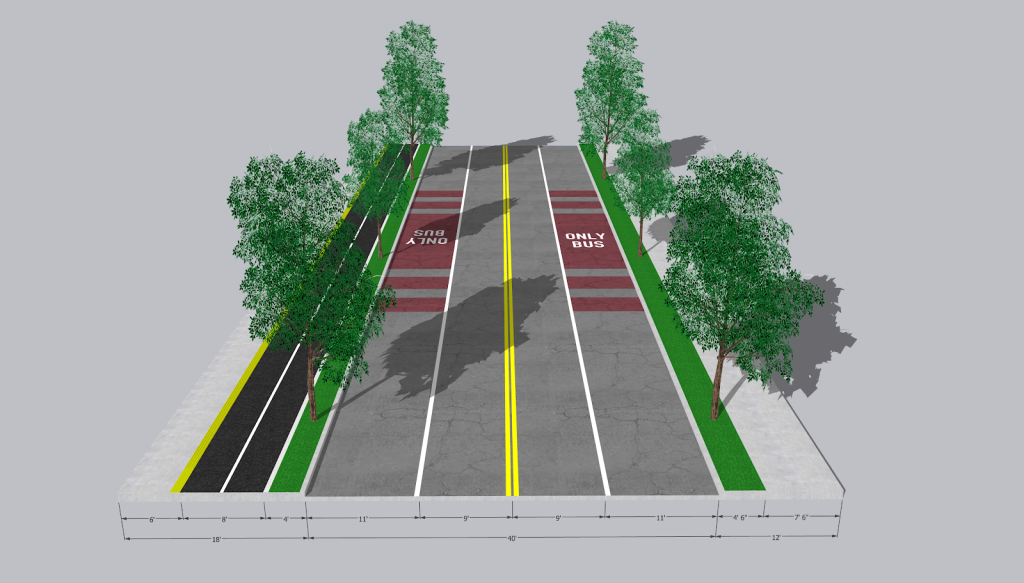
Using data from the National Association of City Transportation Officials (NACTO) for reference, Mangan puts forth the claim that by prioritizing pedestrians, cyclists, and transit, his redesign of NE 45th Street would move substantially more people through the corridor than the existing layout does, although he was unable to create corridor scenario models with the same level of scale and sophistication as SDOT.
Thinking bigger, another concept for improving the NE 45th Street corridor involves building a freeway lid over I-5. The concept was first explored in a community design charrette held by advocacy group Lid I-5 in 2017 and then delved into deeper during a University of Washington design studio in which students examined different factors to take into consideration when planning the future freeway lid between NE 45th and NE 50th Streets. Factors included zoning and land use patterns, transportation infrastructure, demographics and trends, and current and proposed development within the study area. In addition to creating space for pedestrians and cyclists to cross safely, a freeway lid would create land that could be used for green space or even residential or commercial development.
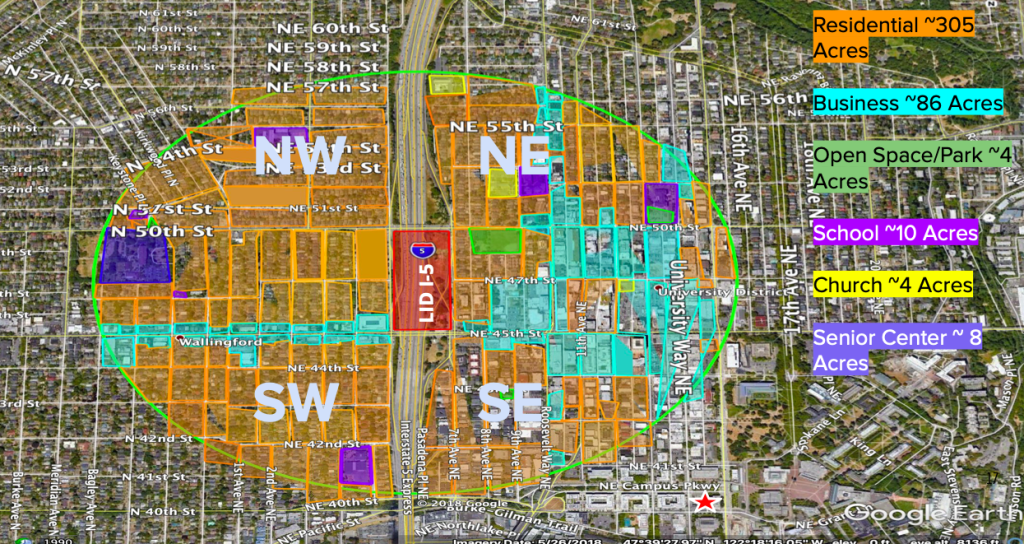
A third plan to build a pedestrian bridge over I-5 at NE 47th Street has come up in conversations around improving the corridor, but failed to make it into official plans or secure a budget, although it is noted as a possible solution in the City’s Bike Master Plan. The recent completion of the John Lewis Memorial bridge near the Northgate Link light rail station may spark new interest in this solution, although Seattle Neighborhood Greenways has been careful to point out that implementing safer bike and pedestrian facilities on the existing NE 45th Street bridge now would be complimentary to a future pedestrian bridge — which even in a best case scenario remains years off from completion.
Recognizing the challenges of designing a transportation system that works for everyone, safe street and neighborhood advocates are nevertheless disappointed to see hard won corridor improvements being shelved for the NE 45th Street bridge. Honoring the requests put forth in the letter from The Urbanist, Transit Riders Union, Cascade Bicycle Club, and Seattle Neighborhood Greenways would represent a step toward remedying safety concerns in a dangerous, but vital, traffic corridor.
Natalie Bicknell Argerious is a member of the Lid I-5 steering committee.
Natalie Bicknell Argerious (she/her) is a reporter and podcast host at The Urbanist. She previously served as managing editor. A passionate urban explorer since childhood, she loves learning how to make cities more inclusive, vibrant, and environmentally resilient. You can often find her wandering around Seattle's Central District and Capitol Hill with her dogs and cat. Email her at natalie [at] theurbanist [dot] org.


